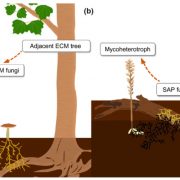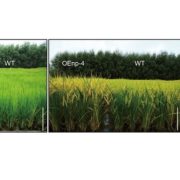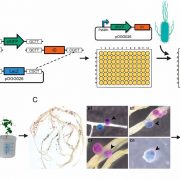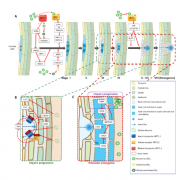Nitrate transporter gene OsNRT1.1A/ OsNPF6.3 confers high yield in rice (Plant Cell)
 In many ecosystems, nitrogen (N) is a limiting factor for plant growth. In agro-ecosystems, the application of synthetic N fertiliser has solved that issue. However, N fertiliser application is costly both to the farmers and the environment (in terms of N leaching and atmospheric release of greenhouse gases). In plants, the basic physiology and biochemistry of N uptake, assimilation and remobilisation towards the seeds, have been mostly elucidated. At the molecular level, the characterisation of genes encoding nitrate transporters has proven both interesting from a fundamental biology viewpoint (e.g., AtNRT1.1 being described as transceptor or membrane protein that function both in transport and signalling) and useful in providing options for improving nitrogen use efficiency (NUE) in crop. Here, Wang et al. have characterised the role of OsNRT1.1a in regulating N-utilisation as well as flowering-related genes in different rice backgrounds and Arabidopsis thaliana. Using mutants deficient in both OsNRT1.1a and OsNRT1.1b as well as over-expressor lines, the authors demonstrate that OsNRT1.1a is a good candidate for improving NUE in rice under both low and high N availability. (Summary by Stéphanie Swarbreck) Plant Cell 10.1105/tpc.17.00809
In many ecosystems, nitrogen (N) is a limiting factor for plant growth. In agro-ecosystems, the application of synthetic N fertiliser has solved that issue. However, N fertiliser application is costly both to the farmers and the environment (in terms of N leaching and atmospheric release of greenhouse gases). In plants, the basic physiology and biochemistry of N uptake, assimilation and remobilisation towards the seeds, have been mostly elucidated. At the molecular level, the characterisation of genes encoding nitrate transporters has proven both interesting from a fundamental biology viewpoint (e.g., AtNRT1.1 being described as transceptor or membrane protein that function both in transport and signalling) and useful in providing options for improving nitrogen use efficiency (NUE) in crop. Here, Wang et al. have characterised the role of OsNRT1.1a in regulating N-utilisation as well as flowering-related genes in different rice backgrounds and Arabidopsis thaliana. Using mutants deficient in both OsNRT1.1a and OsNRT1.1b as well as over-expressor lines, the authors demonstrate that OsNRT1.1a is a good candidate for improving NUE in rice under both low and high N availability. (Summary by Stéphanie Swarbreck) Plant Cell 10.1105/tpc.17.00809









